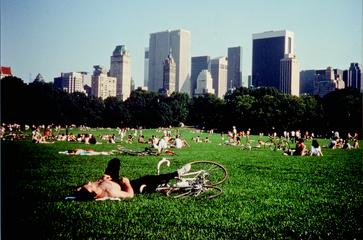Wiseman Smiles Too: CENTRAL PARK

CENTRAL PARK
These notes on Frederick Wiseman's Central Park were written by Matt St. John, PhD candidate in UW Madison’s Department of Communication Arts. A 16mm archival print from Wiseman's Zipporah Films will screen on Friday, October 20 as part of our ongoing Wiseman series in our regular venue, 4070 Vilas Hall.
By Matt St. John
Within our Cinematheque Frederick Wiseman series, Central Park may seem like a surprising follow up to High School (1968), Hospital (1969), and Welfare (1975), the more clearly institution-focused films that we have already screened. This is not solely a result of our selections, as critics commented on Central Park’s departures from Wiseman’s previous twenty-two documentaries when it aired on PBS in 1990. The Los Angeles Times’s Robert Koehler notes that the park “seems like an utterly eccentric subject choice” for Wiseman after so many films about “environments ruled by stress.” In his Washington Post review, Tom Shales describes it as “one of the most accessible and salutary films ever made by master documentarian Frederick Wiseman -- it's even in color.”
Compared to films with extended sequences of people fighting for their welfare benefits or doctors pleading with stubborn patients to remain in their care, a documentary about New Yorkers inhabiting an iconic public space is, in some ways, a shift. While a few of Wiseman’s earlier films dealt with seemingly lighter topics, like Model (1980) and the Neiman-Marcus-focused The Store (1983), Central Park is a notably relaxed portrait of a space that takes on many different meanings for its visitors, supporters, and employees. Wiseman has always attended to the various groups involved with his topics, but Central Park often highlights the people who use the park. And they use it in plentiful ways––exercise, romance, performance, and activism, to name a few.
There are moments of tension and drama, but overall the film offers an impression of a space created for leisure and public gathering that generally fulfills its purpose, even when that requires meetings about rule-breaking cyclists or fiery debates like the hearing about a new tennis house. While the film does acknowledge problems like drugs and homelessness, Wiseman emphasizes the vast array of recreational daytime activities in the park, rather than its widespread associations with crime and fear at the time. As Shales writes in his review, “For the most part, this is a portrait of Central Park smiling. Wiseman seems to be smiling too.”
Even with its different topic, Central Park contains many similarities to Wiseman’s other documentaries. The film lacks voiceovers, explanatory titles, and interviews, and it was produced using lightweight equipment that allowed Wiseman and his cinematographer, John Davey, to be flexible in their shooting locations and selections. Wiseman recorded sound, as he typically does, and worked closely with frequent collaborator Davey to define the aesthetic tendencies of the project. In a 1991 interview with Documentary Magazine, Wiseman stated that he and Davey discussed the film’s style between shots and while watching rushes, saying, “We're talking about it in one way or another all day long and all night long.”
Defining this style, Wiseman explained that Central Park “is not so dependent on talk; it is more of a movie where the pictures tell the story and the sequences are short and each shot that I've used is meant to suggest a story.” This quality appears through the wider shots of the film. In contrast with Welfare’s tight close-ups on faces in intense conversation, for example, Central Park is about a larger scale of activity, with parades, demonstrations, marathons, and picnics. Wiseman also balances the short scenes with longer sequences, like the activist group that passionately argues with park officers over a merchandise-selling policy. This balance of brief and extended events allows Wiseman to include a remarkably varied set of observations in the three-hour film, culled from the eighty hours of material he and Davey recorded in a five-week shoot.
Within these observations, Wiseman uncovers topics that appear often in his other films. While the fundraising and board meetings in Central Park are not a primary focus, they provide some of its most candid discussion about the meanings and functions of the park. The complex interactions of business meetings feature heavily in some of Wiseman’s later projects, like At Berkeley (2013) and this year’s Ex Libris (screening in this series on November 3). In Central Park, his attention to artistic performance includes theater rehearsals, opera productions, and film shoots, and his interest in performance is the structuring topic for films like Ballet (1995), La Danse – Le Ballet de l’Opera de Paris (2009), and the Paris-cabaret-set Crazy Horse (2011). In all of his films, Wiseman discovers unexpected social practices, behaviors, and events, and that tendency is on full display in Central Park, from a festival for Mississippians to a dinosaur celebration, complete with a dinosaur-impression contest. And like all of Wiseman’s work, Central Park contains pronounced traces of the period when it was produced. These range from amusing celebrity cameos (keep an eye out for a younger Francis Ford Coppola) to sobering reminders of crises––a father takes his young children to the AIDS quilt to remember a family friend.
Despite its unusual subject matter, Central Park remains a Wiseman film to its core, endlessly curious about the intricacies of human behavior and emotion, especially in public. He considers it similar to his other films about institutions, because, as he told the New York Times in 1990, “Central Park is a vehicle in which people express their social concerns.” They certainly express (and argue over) concerns in the film, but they also paint, play, sing, dance, mourn, and relax. Above all, people actually choose to be in Central Park and choose what they want to do there, making it one of Wiseman’s most revealing, engaging films about contemporary American life.
